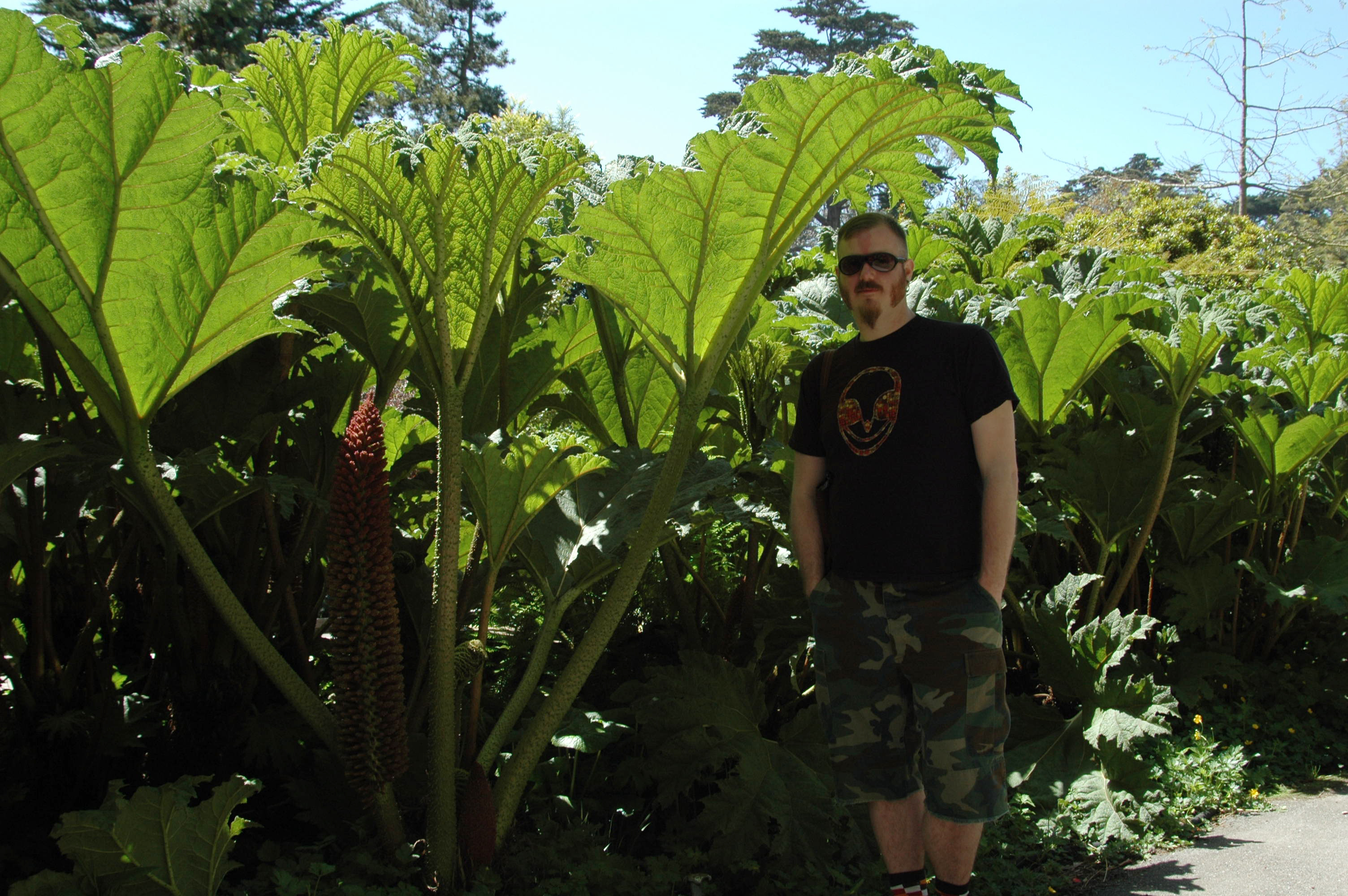- Gunnera
Taxobox
name = "Gunnera"

image_width = 240px
image_caption = "Gunnera tinctoria" at theSan Francisco Botanical Garden at Strybing Arboretum
regnum =Plant ae
divisio =Magnoliophyta
classis =Magnoliopsida
ordo =Gunnerales
familia =Gunneraceae
familia_authority =Meisner
genus = "Gunnera"
genus_authority = L.
subdivision_ranks =Species
subdivision = See text."Gunnera" is a genus of
herbaceous flowering plant s, some of them gigantic. The genus is the only member of the family Gunneraceae.The 40-50 species vary enormously in
leaf size. "Gunnera manicata ", native to the Serra do Mar mountains of southeasternBrazil , is perhaps the largest species, with leaves typically 1.5-2 m (5-6 ft) wide, but exceptionally long, up to 3.4 m (11 ft), borne on thick, succulent leaf stalks (petioles) up to 2.5 m (8 ft) long. It germinates best in very moist, but not wet, conditions and temperatures of 22 to 29 °C.Only slightly smaller is "G. masafuerae" of the Juan Fernandez Islands off the
Chile an coast. They can have leaves up to 2.9 m (9 ft 5 inches) in width on stout leaf stalks 1.5 m (5 ft) long and 11 cm (4.5 in) thick according to Skottsberg. On nearby Isla Más Afuera, "G. peltata" frequently has an upright trunk to 5.5 m (18 ft) in height by 25–30 cm (10–12 in) thick, bearing leaves up to 2 m (6 ft 4 inches) wide. "G. magnifica" of theColombia nAndes bears the largest leaf buds of any plant; up to 60 cm (2 ft) long and 40 cm (16 inches) thick. The succulent leaf stalks are up to 2.7 m (8 ft 10 inches) long. The massiveinflorescence of small, reddishflower s is up to 2.3 m (7 ft 6 inches) long and weighs about 13 kg. Other giant "Gunnera" species are found throughout theNeotropics andHawaii .Several small species are found in
New Zealand , notably "G. albocarpa", with leaves only 1–2 cm long, and also in South America, with "G. magellanica" having leaves 5–9 cm wide on stalks 8–15 cm long.Commonly known as "giant
rhubarb ".This genus was named after the Norwegian botanist
Johann Ernst Gunnerus .;Selected species
*"Gunnera albocarpa "
*"Gunnera arenaria "
*"Gunnera densiflora "
*"Gunnera dentata "
*"Gunnera flavida "
*"Gunnera hamiltonii "
*"Gunnera kauaiensis "
*"Gunnera magellanica "
*"Gunnera magnifica "
*"Gunnera manicata "
*"Gunnera masafuerae "
*"Gunnera monoica "
*"Gunnera perpensa "
*"Gunnera petaloïdea "
*"Gunnera prorepens "
*"Gunnera tinctoria "Cyanobacterial Symbiosis
In nature, all Gunnera plants form a symbiosis with a nitrogen-fixing cyanobacteria, thought to be exclusively "
Nostoc punctiforme ". The bacteria invade the plant via glands found at the base of each leaf stalk [cite journal | doi = 10.1111/j.1469-8137.1992.tb00067.x | title = The Nostoc-Gunnera symbiosis | year = 1992 | author = Bergman, B. | journal = New Phytologist | volume = 122 | pages = 379 ] and initiate an intracellular symbiosis which is thought to provide the plant with fixed nitrogen in return for fixed carbon for the bacterium. This intracellular interaction is unique in higher plants and may provide insights to allow the creation of novel symbioses between crop plants and cyanobacteria, allowing growth in areas lacking fixed nitrogen in the soil.Uses
The stalks of "G. tinctoria" ("nalcas") are edible. Their principal use is fresh consumption, but also they are prepared in salads, liquor or marmalade. Leaves of this species are used in covering
curanto (a traditional Chilean food)."Gunnera perpensa" is used as a source of traditional medicine in Southern Africa.
References
External links
* [http://gunneraceae.googlepages.com/home The Gunnera Gallery]
* [http://www.chilebosque.cl/herb/gmage.html "Gunnera magellanica" pictures from "Chilebosque"]
* Global Invasive Species database [http://www.issg.org/database/species/ecology.asp?si=836&fr=1&sts= Gunnera tinctoria]
* Medicinal plant details [http://www.plantzafrica.com/medmonographs/gunnerapers.pdf Gunnera perpensa]
* Gunnera on Achill Island [http://www.achilljournal.com/index.php/2007/03/20/e15000-for-achills-wild-rhubarb/]
* Fullscreen QTVR panorama [http://www.lookaroundcornwall.com/panos/trebah_gunnera.htm Gunnera Manicata at Trebah Garden Cornwall]
Wikimedia Foundation. 2010.
